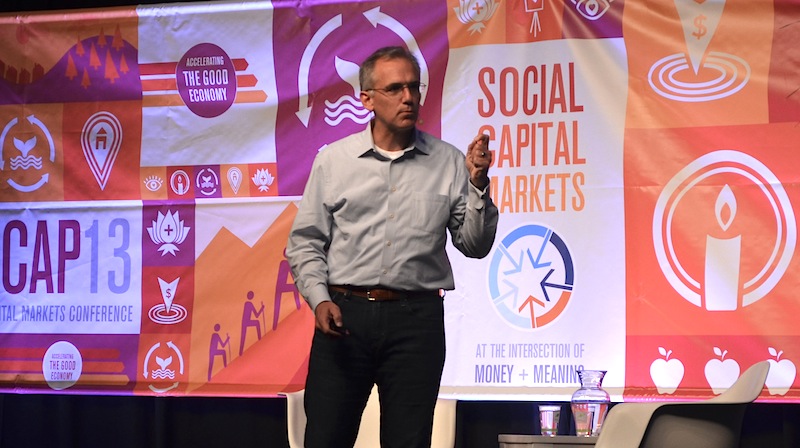Weekly Roundup – SOCAP13 Takeaways: Plus, things we could take away (completely) from buzzwords
For the Social Entrepreneur and the Impact Investor
Regardless of whether “manufacturing,” “inventory,” or “design” follows it, “lean” is a buzz word that has zipped around the business lexicon for the better part of a decade. But a word to the wise: it does not apply well to every sector – including ours, i.e. the social sector.
Like all entrepreneurs, social entrepreneurs fail and screw up. It’s natural and human. We all have initial assumptions that need to be tested before we actually get it right to serve our target community. What doesn’t have to be so big is the fall. That is, being open with funders can offer a cushion for failing and experimentation, especially in light of the time it takes to create lasting impact in the social sector. In other words, enter lean methodology into the equation.
“Before spending a ton of money, use hacks to test the riskiest assumptions of your model. This, in a nutshell, is the core of the lean startup,” Tabreez Verjee of Uprising, a company that invests in mission-driven tech entrepreneurs, told one of the sessions of this year’s Social Capital Markets Conference.
However, the question then becomes “who bears the risk of testing your assumptions?”
In the social sector, the traditional lean method is missing social impact metrics and proper feedback loops. “Without impact metrics, while trying to satisfy the donor community, you can pivot, pivot, pivot away from the impact you’re actually trying to make,” said Chase Adam of Watsi.org. It may not be worth risking social impact to apply lean methodology to have the most successful and viable business.
The social entrepreneur then acts like the intermediary between those in need and the donor community, a delicate balancing act. In a nutshell, lean is not only about experimentation but about understanding the “customer,” whether that means the funding community or the community you’re serving.
Take home message: understand exactly who are the customers for the entire ecosystem of social impact. That is the only way to successfully apply lean methodology to the social sector. Keep calm and be patient with social change – impact takes time. As Christie George, New Media Ventures reminded us: ”It took change.org five years to become an overnight success.”
(“It’s not a sector, it’s a virus. (A social entrepreneur’s) mission is to infect markets,” said Todd Johnson of Designing Business for Good. Image credit: Marzena Zukowska).
For the Designer and the Visual Storyteller
Can the magic of big data really become the panacea for all of our social ailments? Living in an era where numbers about our buying patterns are being crunched at every mouse click, it’s hard to believe that quantifying our actions as a species won’t one day predict our future with complete accuracy. More is better…right?
When using data to capture the human imagination, it’s about more than crunching numbers – it’s about intent. Visualization, or the art of repurposing content, has the potential to activate people.
According to Matthew Scharpnick, of Elefint Designs, who spoke at the big data session at SOCAP, there is more than meets the eye when presenting big data anecdotally. Follow these steps for successful storytelling through data visualization:
1. Know the difference between useless data and useful data. More is not always better, and ‘can instead mask true patterns.
2. Data is not always truthful. It’s important to ask where it comes, who is presenting it, and how it’s being portrayed. Be an investigator.
3. Without a human element to data analysis, the numbers cannot be put into full context.
4. Nuanced approaches are oftentimes the most accurate, but the least appreciated.
5. Data is never a guarantee. Economists have stacks of data, and yet it’s still very, very difficult to predict economic downturns in the business cycle.
6. Data visualization should be compelling and informative, presenting layers of information.
For Everyone Else: ’Acting like a Disruptive Innovation’
Steve Wright, vice president of Tools and Insights at Grameen Foundation, was one of the plenary speakers at SOCAP13 this year, and arguably one of its most memorable. In his capacity as the head of tools and insights, he manages two teams: The first is the Social Performance Management Center, which provides tools and resources on social performance – specifically the Progress Out of Poverty Index® (PPI®). The second is Inclusive Business Tools, which develops and provides TaroWorks, a mobile-enabled, cloud-based information management system designed to improve efficacy and efficiency of those who serve the poor.
It’s exceedingly difficult to distill his talk here to a few key lines without making it sounding trite. So we won’t. But for anyone interested what the bottom line really means for social innovation in economics and more specifically, in communities, we recommend spending 16 minutes to watch it.
– Scott Anderson
In Case You Missed It … This Week on NextBillion
NexThought Monday – Is Charity: Water the Expedia of Philanthropy? By Kyla Yeoman — Mercy Corps
Backpack-equipped Health Care Workers Make a Difference in Rio: Added mobility helps monitor patients, manage diseases in favela By Mathieu Lefevre
The Ripple Effect: Women Powering Work Through Microfinance And Entrepreneurship By Reem Rahman — Ashoka
FEATURED EVENT The BoP Summit 2013: Creating an action agenda for the next decade By NextBillion Editor
New Hospital Chain in India Brings Fresh Approach: Jeevanti looking to improve quality, availability and affordability of secondary health care By Rose Reis
- Categories
- Impact Assessment
- Tags
- impact investing

